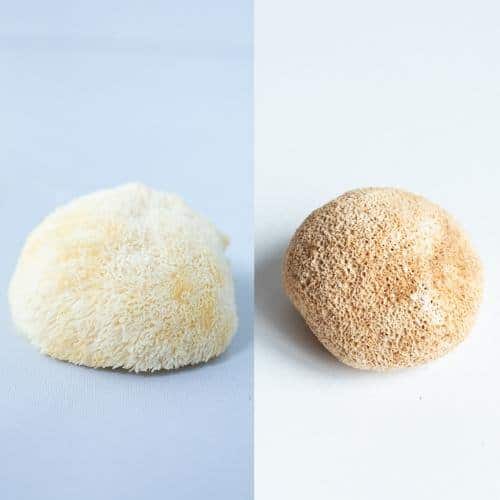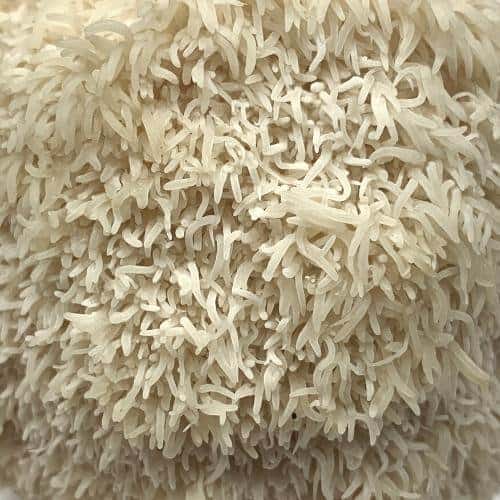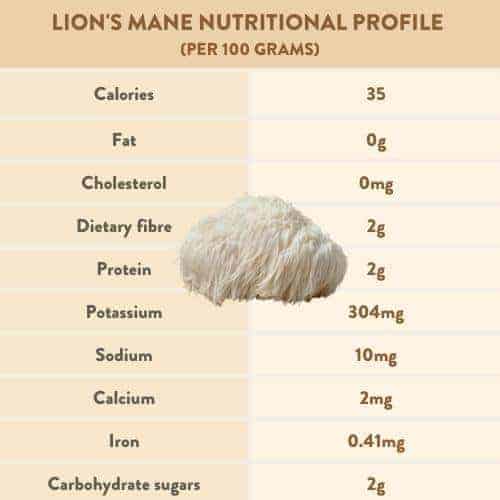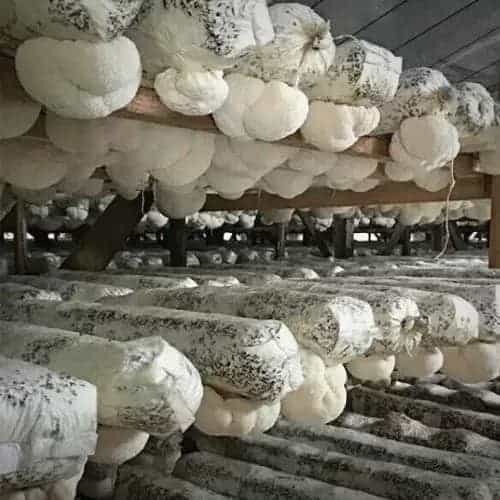Menu


Thinking about cooking lion’s mane mushroom? Maybe you’ve heard of some of the health-supporting benefits of lion’s mane and want to find some tasty ways to add them to your diet.
Perhaps you want to branch out from your standard portobello and button varieties and try your hand at a different gourmet mushroom. Whatever the reason, you’re in the right place to learn how to make the most of cooking this versatile, delicious mushroom.
Along with a couple of simple recipes, we’ll cover where to buy lion’s mane and how to clean, store, and prepare it. We’ll also briefly review some of the fascinating ways this mushroom can support your health.
What’s in this article:

Lion’s mane (Hericium erinaceus) is a common mushroom found throughout the Northern United States and Canada. They’re often found growing on dead and decaying trees, including birch, beech, elm, and oak trees.
The lion’s mane mushroom gets its name from its shaggy, mane-like appearance. They’re large, white, and covered with hair-like structures called teeth that hang down around the mushroom. Its fuzzy appearance is also what earned it the nickname the bearded hedgehog mushroom and the pom-pom mushroom.
This unique mushroom is used all over the world for culinary purposes and for its health-supporting properties. It’s a versatile mushroom and can be enjoyed and eaten raw, cooked, dried, or steeped as a tea. Lion’s mane extracts are often used in supplements for health support.

One advantage of cooking with lion’s mane mushrooms is the health benefits they provide, not to mention they’re delicious! From brain to gut health to being possibly one of the best mushrooms for anxiety, there are a lot of reasons to eat more lion’s mane.
This mushroom has a long history in Asian medicine. In Chinese and Japanese medicine, it has traditionally been used to support spleen and gut health. Traditional Chinese Medicine (TCM) practitioners employ this mushroom to promote good digestion, vigor, and strength [1].
This functional mushroom may be able to support your health in various ways. One of the most exciting discoveries made about them is their potential to support brain health.
Lion’s mane mushrooms contain two unique compounds that may be able to protect the neurons and nerves in our bodies. These compounds are called hericenones and erinacines. Studies show that these compounds may be able to protect the brain from cognitive decline associated with aging [2].
Lion’s mane can increase the production of nerve growth factor (NGF), a compound that maintains neural health in our brains [3]. This compound is linked to supporting the growth of nerve tissue and nerve function as shown in animal studies [2].
Research suggests that this mighty mushroom may also be able to support brain health in other ways, such as:
Lion’s mane may be one of the best mushrooms for anxiety. In a clinical trial, this mushroom was able to decrease feelings of anxiety, irritation, and frustration [6].
Lion's mane could support your health in other areas of your body as well. For instance, it can promote a healthy immune response. Studies show that it can do this by regulating bacteria in the gut and intestines [7].Animal studies also show that these mushrooms can support immune system strength by regulating intestinal mucosal activity [8].
Health Highlight: Preliminary research suggests that lion’s mane could potentially improve sleep quality by supporting overall neural health.
Cooking with lion’s mane mushrooms is also a fantastic way to get more nutrients in your diet. Mushroom proteins contain all the essential amino acids your body needs to stay healthy. Amino acids are the building blocks of each individual cell, and finding complete sources of all essential amino acids is required to give your body the fuel it needs to function.
Together with the low-fat content and high proportion of polyunsaturated fatty acids, these nutritional properties add to the significant health value of lion’s mane mushrooms. When reliable extraction methods are used, lion’s mane extract can be used as a supplement to more easily tap into some of the desirable health-supporting benefits mentioned above [9].
Lion’s mane offers a range of nutritional benefits in addition to its culinary versatility. Below is a chart highlighting the key nutrients found in this remarkable mushroom.

If you’ve never tasted lion's mane mushrooms before, you’re in for a treat. When it’s cooked, it’s juicy, delicate, tender, and meaty.
The taste of lion’s mane mushrooms is best described as seafood-like, and it’s usually compared to crab, lobster, and other shellfish. This is why it’s often used as a vegetarian substitute in seafood dishes.
Flavor Boost: Enhance lion’s mane's seafood-like taste with simple spices like garlic, thyme, and smoked paprika for an extra burst of flavor.
You can purchase lion’s mane mushrooms fresh, dried, or as a powder. Each variety is useful for different culinary purposes.
Fresh and dried lion’s mushrooms may be better for frying and grilling, whereas powders are ideal for broths, baking, and drink mixes.
Mushrooms are very absorbent, which is great for marinades and sauces, but this also means they can absorb pesticides. That’s why it’s best to purchase organic lion’s mane mushrooms.
If you’re on the hunt for fresh or dried lion’s mane mushrooms, the first place to look would be your local health food or farmer's market. They are sometimes sold in Asian markets as well.
Just make sure they are grown organically.
Not having any luck finding them in your area? Organic mushroom powders can be found in some health food stores and easily online. If you are buying mushroom powders to support your health, make sure you are buying the highest quality product.
Check out our four-point buying guide for lion’s mane powder extracts to learn how to spot a quality mushroom product.


To make the most of your lion’s mane mushrooms, it’s important to store and clean them properly. Here’s how to keep your mushrooms fresh and ready for cooking.
Fresh is always best. But you don’t want any extras to go bad before you can enjoy them. If you’re not planning on eating them right away, you’ll need to store them properly.
Storage Tip: Always use a paper bag. Plastic bags trap moisture and can lead to quicker spoilage, while paper bags allow the mushrooms to breathe and stay fresh longer.
Once your mushrooms are clean, you can preserve them by dehydrating or freezing to ensure they stay fresh and retain their nutritional value. These methods allow you to enjoy lion’s mane mushrooms long after they’ve been harvested.

The best way to cook lion’s mane mushrooms is to sauté or roast them. Once they’re cooked, you can eat them in a sandwich, stir-fry, or on their own.
Sautéing or roasting is a great place to start if you’ve never cooked lion’s mane mushrooms before. If you’re feeling more adventurous, you could try making your own lion’s mane “crab” cakes, or using them in a vegan lobster roll.
Proper preparation is essential when figuring out how to eat lion’s mane mushroom in different dishes. Rinse them in water or use a mushroom brush to remove any excess dirt. If rinsed, set them out to dry for a couple of hours, preferably in sunlight, so the extra water evaporates.
The bottom of the mushroom is likely dirty and maybe a little tough. You’ll want to cut that piece off and any other dirty or yellowing spots.
Depending on the dish you’re using your mushrooms in, you can either cut them into slices or shred them into pieces.
If slicing, use a chef's knife to cut the mushroom in half from top to bottom. From there, you can cut it into half-inch segments for a thicker slice, or quarter-inch segments for a crispier slice.
If shredding, you can simply use your hands to pull the mushroom apart into bite-sized pieces. Just like with slicing, the smaller you shred the mushroom, the crispier it will be.
Quick Tip: For even cooking, try to keep all your mushroom slices or pieces a uniform size. This ensures they cook at the same rate and achieve the desired texture.
Sauteing is an easy and quick way to prepare lion’s mane mushrooms. Here is a tasty and simple recipe for sauteing mushrooms.
Ingredients:
Directions:
Roasting is a decadent way to cook lion’s mane mushrooms without having to do a ton of prep work. Try this method to impress your friends and family at your next dinner party.
Ingredients:
Directions:
We’ve assembled a collection of seven more delicious meals that you can make using this mushroom in our article, “Lion’s Mane Recipes: 7 Creations Using This Unique Mushroom.”
We hope you have fun trying these tasty lion’s mane recipes! We’d love to hear how they worked for you. Share your mushroom dishes in our Facebook Group or on Instagram, and don’t forget to tag @Real_Mushrooms.

Disclaimer: The information or products mentioned in this article are provided as information resources only, and are not to be used or relied on to diagnose, treat, cure, or prevent any disease. This information does not create any patient-doctor relationship, and should not be used as a substitute for professional diagnosis and treatment. The information is intended for health care professionals only. The statements made in this article have not been evaluated by the Food and Drug Administration. Any products mentioned are not intended to diagnose, treat, cure, or prevent any disease. The information in this article is intended for educational purposes. The information is not intended to replace medical advice offered by licensed medical physicians. Please consult your doctor or health practitioner for any medical advice.
